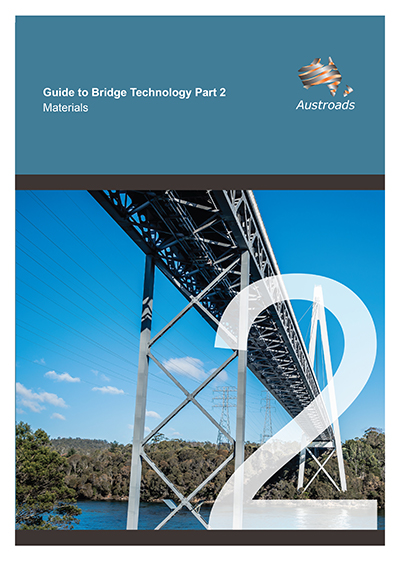Bridges

Guide to Bridge Technology Part 2: Materials
- Publication no: AGBT02-18
- ISBN: 978-1-925451-91-7
- Published: 19 February 2018
- Edition: 2
- PDF (free) Download
- View online View guide
Guide to Bridge Technology Part 2 covers all aspects of the common building materials available to the engineer including concrete, masonry, metallic and non-metallic materials and timber. This Part discusses material characteristics, their properties, durability, construction issues, and protection and preservation treatments. A detailed section on concrete reinforcing materials is also included.
Edition 2.0 provides updated details and information on various sections, and removing overlapping information. Major changes include:
- Section 2 Concrete Characteristics and Materials
- Combined original Section 2 and Section 4 and changed the section title.
- Added Section 2.1 Properties of Concrete, Section 2.2 Specification, Section 2.7 Concrete Mixes, Section 2.11.4 Mass Concrete Placement, Section 2.13.3 Ultra-high Performance Concrete, Section 2.13.5 Geopolymer Concrete.
- Moved selected texts from the Austroads Guide to Bridge Technology (AGBT) Part 7 and incorporated into Section 2.9.1 Cracking.
- Moved ‘Grout and mortar’ to a separate section (Section 5).
- Section 3 Concrete Reinforcing Materials
- Updated information on material certification in Section 3.1 Manufacture and Supply.
- Added Section 3.2.7 Welding Procedure Testing, Section 3.3.2 Material Characteristics, and Section 3.6 FRP Reinforcing Material.
- Added information on ‘failure at couplers’ in Section 3.4.9 Construction Issues.
- Section 4 Concrete Durability
- Renamed from the original Section 5.
- Revised Section 4.1 Concrete Distress Mechanisms with supplemented information taken from the AGBT Part 7 .
- Added Section 4.2.1 Environmental Exposure Classifications, and Section 4.2.2 Minimum Requirements for Concrete Materials in Adverse Environments.
- Added brief descriptions of additional techniques for concrete durability assessment such as ultrasonic pulse velocity, half-cell method, delamination detection machinery, and infrared thermography.
- Added information on the statistical method for determining concrete compressive strength in Section 4.3.13.
- Section 8 Steel Distress Mechanisms and Defects
- Swapped Section 7 and Section 8.
- Added Section 8.5 Unusual Deterioration Mechanisms and Section 8.6 Steel Bridge Defects incorporating information taken from the AGBT Part 7 .
- Added Section 10 Masonry.
- Revised Section 11 Non-metallic Materials to address recent updates on FRP materials.
-
-
-
-
- 3.2.1 Material Characteristics
- 3.2.2 Method of Manufacture
- 3.2.3 Old Reinforcing Steels
- 3.2.4 Packaging and Handling
- 3.2.5 Ductility
- 3.2.6 Weldability
- 3.2.7 Welding Procedure Testing
- 3.2.8 Macro Test
- 3.2.9 Tack Welding
- 3.2.10 Welded Splices
- 3.2.11 Mechanical Splices and Mechanical Couplers
- 3.2.12 Rebending
- 3.2.13 Protective Treatments
- 3.2.14 Fire Damage to Steel
-
-
- 4.2.1 Environmental Exposure Classifications
- 4.2.2 Minimum Requirements for Concrete Materials in Adverse Environments
- 4.2.3 Concrete Cover Thickness
- 4.2.4 Curing
- 4.2.5 SCMs
- 4.2.6 Waterproofing Membranes
- 4.2.7 Protective Coatings
- 4.2.8 Hydrophobic Impregnating Materials
- 4.2.9 Corrosion Inhibitors
- 4.2.10 Cathodic Protection
-
- 4.3.1 Desktop Investigation
- 4.3.2 Visual Inspection
- 4.3.3 Defect Mapping
- 4.3.4 Measurement of Crack Development
- 4.3.5 Cover Surveys
- 4.3.6 In Situ Compression Testing
- 4.3.7 Ultrasonic Pulse Velocity
- 4.3.8 Ground Penetrating Radar
- 4.3.9 Permeability and Water Absorption
- 4.3.10 Half-cell Method
- 4.3.11 Delamination Detection Machinery
- 4.3.12 Infrared Thermography
- 4.3.13 Concrete Sampling
-
-
-
-
-
Tables
-
Figures
Related publications
ABC2022-110-22
Latest Bridges News
